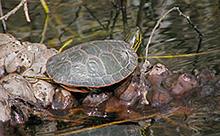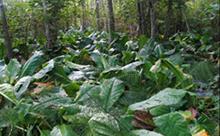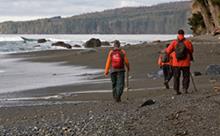What is a Watershed?
A watershed is the area of land that drains surface water and groundwater to a common water body, such as a creek, stream, lake or the ocean. We all live in a watershed, regardless of how far we are from a body of water; therefore, the activities we do on land impact our water quality.
The capital region is comprised of over 300 watersheds. Find out which watershed you live in, and learn about how these natural resources are an important part of our environment.
The Importance of Watersheds
 Watersheds are an important natural resource for both people and wildlife. Watersheds provide many beneficial services to us and the environment. A functioning watershed slows, cleans, filters and stores water by allowing water to absorb into the ground. This process improves water quality, reduces risk of flooding, reduces risk for invasive species to establish and increases resilience within a changing climate.
Watersheds are an important natural resource for both people and wildlife. Watersheds provide many beneficial services to us and the environment. A functioning watershed slows, cleans, filters and stores water by allowing water to absorb into the ground. This process improves water quality, reduces risk of flooding, reduces risk for invasive species to establish and increases resilience within a changing climate.
- Rivers and streams nourish and connect ecosystems throughout the watershed.
- Wetlands and lakes help to store and filter water, and provide habitat for fish and wildlife.
- Upland forests and meadows provide habitat for wildlife and nutrients for aquatic ecosystems, and encourage infiltration of rainwater into the ground.
- Watershed sources, such as reservoirs and groundwater, supply us with clean water for drinking and irrigation.
- The various components of watersheds provide opportunities for recreation, tourism, education and aesthetic appreciation.
Our Impact on Watersheds
 Over the years we have changed many of our natural watersheds into urban watersheds. Urban watersheds are mainly covered in impermeable surfaces (parking lots, buildings, roads, etc.) causing water to flow quickly across surfaces, picking up debris and pollution, and draining into storm drains which lead directly to waterways including our creeks, rivers and ocean.
Over the years we have changed many of our natural watersheds into urban watersheds. Urban watersheds are mainly covered in impermeable surfaces (parking lots, buildings, roads, etc.) causing water to flow quickly across surfaces, picking up debris and pollution, and draining into storm drains which lead directly to waterways including our creeks, rivers and ocean.
Natural Watersheds
Most natural watersheds consist of mature forests, sometimes interspersed with open meadows. The soil in forests consists of plants, fungi and decaying organic material that soaks up moisture and encourages infiltration. In these conditions, approximately 50% of precipitation infiltrates the soil. This leaves only 10% of precipitation, which flows across the soil surface into streams and other water bodies. By the time this precipitation reaches a water body, it has been highly filtered and cleansed by plant roots and forest debris.
Urban Watersheds
In urban areas, large expanses of roads, parking lots and building roofs replace the forest and organic soils. These impervious surfaces do not allow water to soak into the ground (only 5% to 35% of all  rainfall) and evapotranspiration is also substantially reduced. This means 30% to 70% of rainfall in urbanized watersheds runs off almost immediately into storm drains, and subsequently into natural water bodies.
rainfall) and evapotranspiration is also substantially reduced. This means 30% to 70% of rainfall in urbanized watersheds runs off almost immediately into storm drains, and subsequently into natural water bodies.
When rainwater falls, it takes different routes across the land as it flows downhill towards the ocean. Substances present on the land and in the air can be picked up along the way, and are transported into our waterways.
- Domestic pesticides can end up in a lake or harbour, harming fish and other wildlife
- Livestock manure, if stored uncovered and exposed to rain, can cause bacterial contamination of marine shellfish
- Oil and gasoline that contains toxic compounds is eventually flushed into the ocean by the rain, threatening marine life
- Increased runoff causes habitat and stream erosion, murky water and unstable flows
You can help support the protection of our watersheds by reducing the amount of water flow from your property and by preventing pollution from activities we do on the land.
Current Condition of CRD Watersheds
The CRD monitors water quality in creeks around our region. Many of these creeks are no longer suitable for fish habitat or habitat for other aquatic life.
 In our region, contamination from metals, phosphorus, and bacteria as well as murky water due to turbidity are common in our waterways. Possible causes include malfunctioning septic systems, land development or agricultural and land-clearing practices as well as animal and pet waste. Turbidity from unstable flows causes erosion, reduced oxygen and unstable temperatures for fish and aquatic habitat. Elevated levels of metals (i.e., cadmium, copper, zinc) from former industrial practices are also a concern in some creeks.
In our region, contamination from metals, phosphorus, and bacteria as well as murky water due to turbidity are common in our waterways. Possible causes include malfunctioning septic systems, land development or agricultural and land-clearing practices as well as animal and pet waste. Turbidity from unstable flows causes erosion, reduced oxygen and unstable temperatures for fish and aquatic habitat. Elevated levels of metals (i.e., cadmium, copper, zinc) from former industrial practices are also a concern in some creeks.